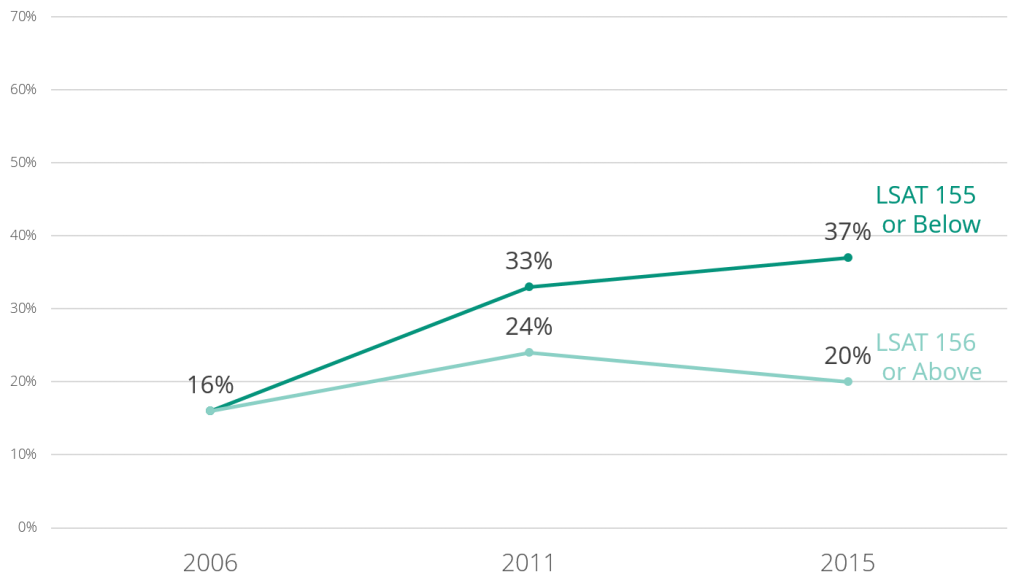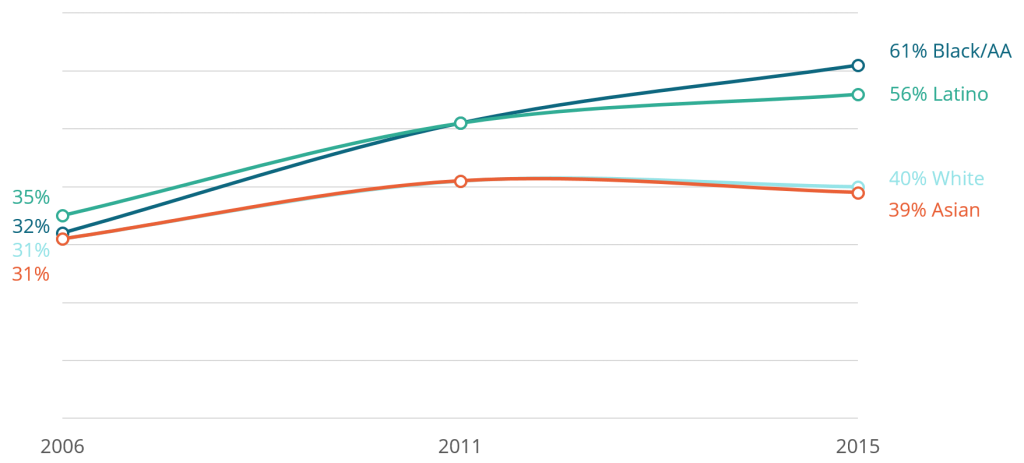LSSSE Annual Results: Lower LSAT Score, Higher Debt
This is the fourth installment in a series of posts centered around data from the 2015 LSSSE Survey administration and the 2015 Annual Report, which provides a retrospective glimpse into law student debt trends over a 10-year period, 2006 to 2015, with 2011 as a midpoint. This post discusses student debt trends through the lens of LSAT scores.
The Law School Admission Test (LSAT) looms large in the law school admissions process. Applicants with high scores tend to have the best chances of being offered both admission and lucrative scholarships. The latter trend has potential implications on student debt trends. The more that a student’s costs of attendance are discounted, the less that student has to borrow. And across the entire system of legal education, it seems logical that student debt trends would share some relationship with trends pertaining to the awarding of scholarships and grants.
For each LSAT grouping, the proportion of respondents who expected to owe more than $120,000 was higher in 2015 than in 2006. But the intensity of these increases was greater for respondents with LSAT scores of 155 or below. In 2006, the proportion of these “lower-LSAT” respondents who expected to owe more than $120,000 was 16%–the same proportion as their “higher-LSAT” peers. By 2015, however, the proportion for the lower-LSAT group was 37%, almost double the 20% proportion of the higher-LSAT group. The trends were even starker for respondents with LSAT scores of 145 or below. In 2006, 15% of these respondents expected to owe more than $120,000; in 2015, that proportion was 52%. [i]
At the other end, in each survey year, respondents in the higher-LSAT groupings were more likely to expect no debt than other respondents; but these trends became more apparent in 2015. In 2006, 12% of respondents with LSAT scores of 156 or above expected no debt, compared to 10% of respondents with lower scores. In 2015, the proportion of no-debt expectations within the higher-LSAT group increased to 20%, while the proportion within the lower-median group remained at 10%.
[i]. Proportion of expected debt, by LSAT Scores
Just hours after Jeff and Mackenzie Bezos unexpectedly released a joint statement on their divorce, it became known that the billionaire’s heart was already reoccupied. So the newly Jeff Bezos girlfriend single girlfriends who had been rejuvenated were reassured once again. The American journalist Lauren Sanchez became the new girlfriend of the Amazon founder. And here is what we know about her.

LSSSE Annual Results: Black and Latino Respondents Expected The Most Debt
This is the third installment in a series of posts centered around data from the 2015 LSSSE Survey administration and the 2015 Annual Report, which provides a retrospective glimpse into law student debt trends over a 10-year period, 2006 to 2015, with 2011 as a midpoint. This post discusses student debt trends based on race and ethnicity. For sake of clearer explication of trends, this post focuses on respondents who identified as Asian, Black, Hispanic/Latino, or White.
Reliance on student loans is largely a reflection of wealth and access to alternative sources of funds. Students from less affluent backgrounds tend to rely on student loans to greater extents than their more affluent peers. This means that the large racial and ethnic wealth disparities in the U.S. have broad implications on student debt trends.
In each of the survey years, white and Asian respondents were more likely than black and Latino respondents to expect no debt. Regarding high debt, a telling trend was observed. In 2006, there were only marginal racial and ethnic differences in expectations of more than $100,000 in debt. By 2011, however, clear disparities emerged, with black and Latino respondents more likely to expect debt at this level. By 2015, the disparities became more intense, with 61% of black respondents and 56% of Latino respondents expecting debt at this level, compared to about 40% of white and Asian respondents. That year, 43% of black respondents expected to owe more than $120,000—the first time a racial or ethnic group crossed the 40% threshold on any LSSSE debt category.[i]
[i]. Proportion of expected debt at various levels, by race



